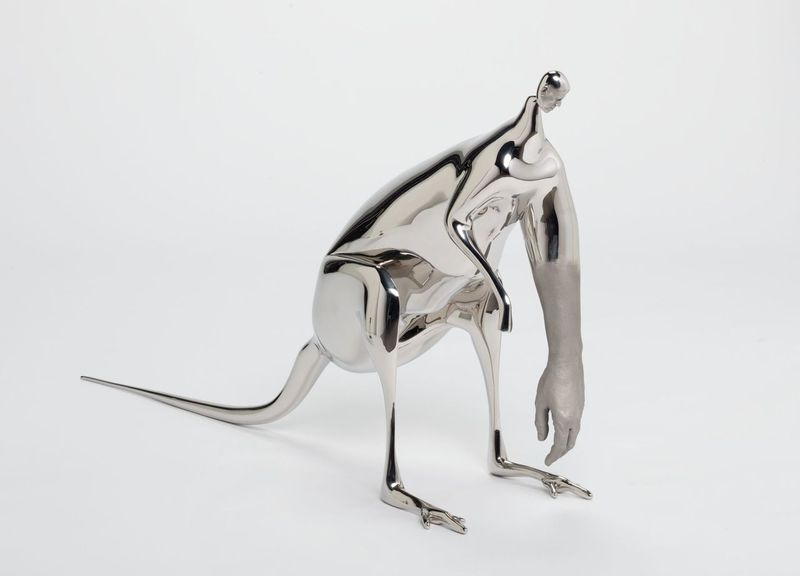Famous for its outdoor sculpture garden, Walker Art Center will draw attention indoors with its new exhibit, “Sculpture Court,” featuring works from the center’s archive in a take on the centuries-old tradition of observation.
Curated by Henriette Huldisch, chief curator and director of curatorial affairs, “Sculpture Court” includes 20 pieces interpreting the human form from the early 1900s through 2024.
“Stretching back to the Renaissance, sculpture courts stood as symbols of power and prestige,” according to the exhibition’s description. “Their contents conveyed religious and mythological narratives, demonstrated political authority and consolidated cultural ideals about beauty and style.”
The yearlong exhibition features traditional studies of the human body, like Polish-American sculptor Elie Nadelman’s “Figure,” circa 1925, that greets visitors at the beginning of the space. Its marble female form is flowing and naturalistic in its posing, welcoming its audience into the room.
Made out of marble, the statue stands apart from Nadelman’s traditional sculpture work. Drawing back to the traditional sculpture work of 19th and 20th centuries, Nadelman’s “Figure” resembles the traditional studies of the Venus figurine and its later interpretations by artists such as Alexandros of Antioch and his work “Venus de Milo.”
Nadelman came to New York City in 1914, after working in Paris in his youth. He became a celebrated sculptor for his works that focused on classical forms with folk art influenced before falling into obscurity in the years preceding his death, according to the Smithsonian American Art Museum and Renwick Gallery.
The piece was gifted to the Walker in 1955 by the T. B. Walker Foundation.
It is contrasted by the bronze sculpture placed behind it, “Femme debout (Standing Woman),” by Spanish artist Joan Miró. The landscape of the form’s body parts morphs, emphasizing different aspects while reducing others, like arms and legs.
Miró was a prolific artist, recognized as a painter, sculptor, printmaker and ceramicist. The Walker’s piece was one of a series of bronze sculptures he made prior to his death in 1983.
Incorporating elements of the female figure in abstraction, Miró originally envisioned this piece as a small, table top sized figurine and not the massive bronze sculpture it would be come, according to an article by Christie’s.
The sculptures somewhat hulking figure contrasts the surrounding pieces, as it exaggerates but does not mock the human figure, inviting further study.
The piece was a gift of the Pierre Matisse gallery and the T. B. Walker Acquisition Fund in 1973.
“It’s, in a way, like a very somewhat quirky and selected survey of 20th century sculpture as represented in our collection,” Huldisch said.
The exhibit is held in Gallery D, a high-ceilinged room that evokes the traditional layout of a sculpture court. It was designed as a twist on the Edinburgh College of Arts at the University of Edinburgh, which invites artists to sit and sketch the figures present.
“It has cathedral-like proportions or much like the proportions of many sculpture courts,” Huldisch said. “So this is, you know, somewhat of a twist on that. Maybe somewhat of a humorous twist.”
All of the pieces featured are from the Walker’s collection, many of which have not been on display in some time.
“A lot of of them, many of us have seen for years, just sitting in storage. So it was really nice to bring some of these up,” Huldisch said.
The assorted figures range in medium, from traditional bronze and marble statues to those made of fiberglass and resin. One sculpture is entirely made out of human hair.
“Hair Necklace,” by Palestinian artist Mona Hatoum, was carefully crafted out of her own hair, with each piece shaped into delicate beads for the necklace. This piece was a favorite of curatorial fellow Laurel Rand-Lewis, who helped organize the exhibit.
“It’s figurative; it’s also a rendering of herself by materials from the body,” Rand-Lewis said. “So this is a bit more abstracted version of that.”
The necklace itself is made out of hair collected from the artist by the artist, as a twist on the self-portrait. While somewhat off-putting in concept, the delicate beads of hair reflect the time and care that was poured into the piece by Hatoum.
Now living in London, the 73-year-old artist communicates her beliefs and struggles through her artwork, like her 1993-99 piece “Keffieh,” which shows her hair woven into the recognizable pattern. This piece is on display at the Museum of Modern Art in New York.
Both pieces incorporate a sense of Hatoum’s personal history, on display for visitors to observe and absorb.
“Hair Necklace” was gifted to the Walker by Donna MacMillan in 2015.
While featuring sculpture, the exhibit will also have drawing pads and materials for the public to encourage visitors to sit and sketch what they see.
“I hope people will just take an opportunity to wander and spend time and reflect, and maybe sit down to sketch,” Huldisch said.
‘Sculpture Court’
Where: Walker Art Center, 725 Vineland Pl, Mpls.
When: Through Sep. 6, 2026
Tickets: $18, available at walkerart.org
Related Articles
‘Vatican Unveiled’ coming to the Mall of America in January
Five things to know about the Julia Child exhibit at the MN History Center
Leapin’ Lena’s stick is now a part of Stillwater history
Michelle Goldberg: Echoes from Poland as Trump tries to make museums submit
‘Monopoly: St. Paul Edition’ hits the landmarks, nails the Minnesota-isms in Thursday debut


Leave a Reply